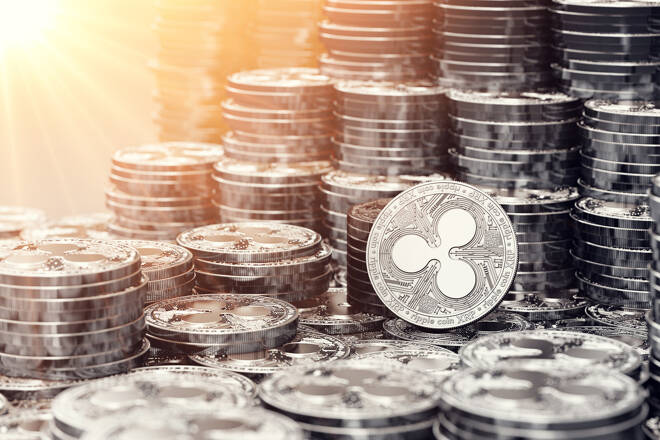Advertisement
Advertisement
XRP Price Return to $0.40 Hinged on US Inflation and SEC v Ripple News
By:
Following the bullish Thursday session, XRP was under pressure this morning. US economic indicators and SEC v Ripple chatter will be key drivers today.
Key Insights:
- On Thursday, XRP rose by 2.94%. Reversing a 2.26% loss from Wednesday, XRP ended the day at $0.39444.
- A lack of SEC v Ripple updates left XRP in the hands of the NASDAQ Composite Index and the broader crypto market.
- The technical indicators turned bullish, with XRP above the 100-day EMA, signaling a possible return to $0.40.
On Thursday, XRP rose by 2.94%. Reversing a 2.26% loss from Wednesday, XRP ended the day at $0.39444. Notably, XRP fell short of $0.40 for the seventh consecutive session.
Bullish throughout the session, XRP rose from an early low of $0.38324 to a late high of $0.39580. XRP broke through the First Major Resistance Level (R1) at $0.3924 to end the day at $0.39444.
US Stats and the NASDAQ Deliver XRP Price Support
Following Wednesday’s sell-off, fueled by fears of a global economic recession, investor focus shifted to the US labor market. Last week’s US Jobs Report delivered Fed monetary policy uncertainty, weighing on riskier assets. However, Thursday’s jobless claims figures supported a December Fed pivot and riskier assets.
The NASDAQ Composite Index rose by 1.13%, supporting a bullish XRP session.
There were no updates from the ongoing SEC v Ripple case, leaving XRP in the hands of the broader crypto market. XRP price movements will remain hinged on the SEC v Ripple case. With investors awaiting a Court ruling on the Summary Judgment Reply briefs, investor angst has crept in, pinning XRP back from a return to $0.40.
While there were no updates, Amicus Curiae counsel John Deaton was vocal on Twitter throughout the session. In reference to the famous William Hinman speech, Deaton said,
“Judge Netburn specifically held that the way the SEC treated and evaluated BTC and ETH was relevant when considering the objective standard to be applied to the recklessness issue. Clayton and the SEC made a big mistake.”
Deaton elaborated by saying,
“The SEC was playing the role it plays best: BULLY. If they didn’t charge the two executives w/ aiding and abetting, the Hinman emails may never have been ordered to be turned over.”
The issue of recklessness relates to the SEC case against Chris Larsen and Brad Garlinghouse. Deaton highlighted that,
“the judge has to conclude, as a matter of law, the two executives were reckless in not knowing XRP was a security. Not negligent – but reckless!”
Barring an unexpected Court ruling or a settlement, we expect the related commentary to continue providing XRP price action.
However, US wholesale inflation figures will influence later today. Market angst over the economic outlook and Fed monetary policy leaves XRP and the broader crypto market at risk of a pullback should wholesale inflation point to a further pickup in consumer prices.
XRP Price Action
At the time of writing, XRP was down 0.30% to $0.39324. A mixed start to the day saw XRP rise to an early high of $0.39494 before falling to a low of $0.39302.
Technical Indicators
XRP needs to avoid the $0.3912 pivot to target the First Major Resistance Level (R1) at $0.3991 and $0.40. A return to $0.3950 would signal a bullish session.
In the case of an extended rally, the bulls would take a run at the Second Major Resistance Level (R2) at $0.4037. The Third Major Resistance Level (R3) sits at $0.4163.
A fall through the pivot would bring the First Major Support Level (S1) at $0.3865 into play. However, barring an extended sell-off, XRP should avoid sub-$0.38 and the Second Major Support Level (S2) at $0.3786. The Third Major Support Level (S3) sits at $0.3660.
Chatter relating to the redacted Summary Judgment Reply briefs and updates from the SEC v Ripple case will continue to influence.
The EMAs and the 4-hourly candlestick chart (below) sent a more bullish signal.
At the time of writing, XRP sat above the 100-day EMA, currently at $0.39040. The 50-day EMA closed in on the 100-day EMA, with the 100-day EMA narrowing to the 200-day EMA. The signals were bullish.
A hold above the 100-day EMA ($0.39040) would support a breakout from the 200-day EMA ($0.39859) and R1 ($0.3991) to target R2 ($0.4037). However, a fall through the 100-day ($0.39040) and the 50-day ($0.38907) EMAs would bring S1 ($0.3865) and sub-$0.38 into play.
About the Author
Bob Masonauthor
With over 28 years of experience in the financial industry, Bob has worked with various global rating agencies and multinational banks. Currently he is covering currencies, commodities, alternative asset classes and global equities, focusing mostly on European and Asian markets.
Did you find this article useful?
Latest news and analysis
Advertisement
